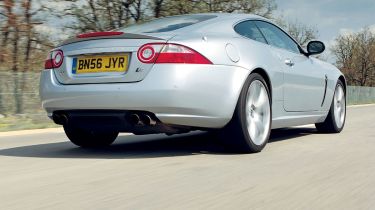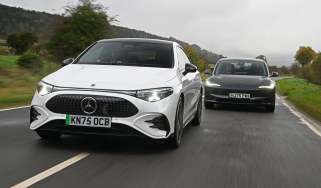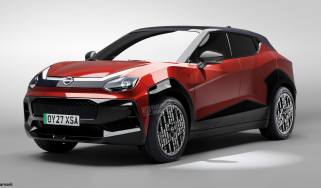Jaguar XKR Coupe
Can the supercharged Big Cat leap ahead of its more expensive rivals?
Compared with the financial stability of the German marques, the British sports car industry often seems to be in a state of flux. Ford’s ownership of Aston Martin recently came to an end, and rumour has it that the US giant is looking to offload Jaguar, too.
But despite this uncertainty, the firm still manages to turn out cars as good looking as the XK. Fair enough, it doesn’t have the visual drama of the R8, nor such taut lines as the Aston, but there’s no denying it’s extremely elegant and well proportioned. But we’re not sure the R additions sit that well on the refined body – the bonnet slats are OK, but the mesh grille and intakes look like an afterthought.
The trouble is that Jaguar needed to add extra impact to a body that’s more GT than sports car, and the results don’t blend in effortlessly. Especially on such a large frame – the XKR is significantly taller and more than a foot longer than any rival.
This doesn’t mean it’s unwieldy to drive, though. All-round visibility is good, and the relaxing cabin ensures it’s an enjoyable place to spend time in. The materials used in its construction aren’t as tactile as the Aston’s, and as a result it doesn’t have the same air of quality. But the layout is good, cubby space is reasonable and the touch-screen on the centre console is easy to operate.
There are even some rear seats – although they don’t seem to have been designed with adults in mind. The boot is better, though. It has the same quoted capacity as the Aston’s, but offers more usable space. From a practical point of view, the Jag is very easy to get on with.
Accessing the performance is equally simple. The 4.2-litre V8 is the only unit here to employ a forced induction system, and the supercharger provides effortless torque and rapid response from below 2,000rpm. But although it delivers surging acceleration, you don’t feel as involved in the process. The automatic gearbox is partially to blame, but it’s worth pointing out that the six-speed set-up does have an excellent manual paddleshift function that delivers crisp, fast and smooth changes.
However, it’s only those outside the car who get the full benefit of the growling exhaust note. From inside, the soundtrack is dominated by the supercharger’s whine, which is nowhere near as exciting. The XKR is simply too well insulated, and this level of refinement takes the edge off the Jag’s sporting credentials.
These take a further knock courtesy of the brakes. Four emergency stops from 70mph had them smoking, and they lack power and feedback compared to rivals, so are the least reassuring here. True, they have to cope with more weight, but thanks to aluminium construction, 1,665kg isn’t bad for a car of this size and power.
Yet the XKR still comes across as heavy in such talented company. The steering is lighter and less informative, while a higher centre of gravity makes the Jag feel slightly ponderous. Press on, and the tyres soon start to squeal. Considering this is supposed to be the high-performance R model, we expected it to be firmer and more agile.
Instead, the XKR excels as a cruiser. The ride on the adaptive dampers is beautifully controlled and soothing, it only pulls 2,000rpm at 70mph and the noise levels were by far the lowest here. It’s also the cheapest and the best equipped as standard – the Jaguar’s options list fits on a single page; the Porsche’s is 39 pages long.
Details
Price: £67,585
Model tested: Jaguar XKR Coupé
Chart position: 4
WHY: The supercharged Jag offers effortless performance and peerless long-distance ability.
Economy
We’ve never found Jaguar’s V8 all that efficient, despite claims of 22.9mpg on the combined cycle. It topped 18mpg on the motorway, but often dropped below 14mpg.
Residuals
While the Jag has strong residuals and relatively cheap servicing, its big fuel bills, plus insurance and tax, mean drivers will pay more than £1.50 for every mile.
Servicing
Choose the XKR rather than the 911, and service costs are nearly halved to £759. However, you’ll also be visiting the main dealer’s workshop twice as often.
Tax
The XKR is nearly £10,000 cheaper than any rival in this test, which is reflected in the contract hire bill. But even then, a monthly outlay of £1,278 is still pretty hefty.



